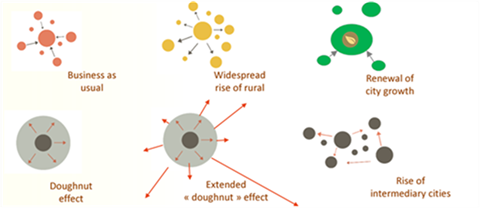Intermediary cities are small and mid-sized settlements playing an “intermediation” role, meaning that they have relevant functions in terms of managing flows of people, goods, capital, information and knowledge. They are “territorial hubs”, meaning that their functions go beyond settlement boundaries and relate to their surrounding urban and rural territories. For instance, they connect urban and rural areas, in terms of the supply of services and opportunities (urban-rural linkages).
Intermediary cities have a key role for regional development, which depends on their territorial context. For instance, within rural and remote regions (often affected by depopulation, ageing and loss of talents), they by supply key services and opportunities (e.g. education, healthcare, jobs) to support regional development and well-being. Conversely, in highly urbanised regions dominated by large cities and their suburban areas, they can contribute to alleviate the negative effects of urban agglomeration, such as excessive cost of housing, congestion, and the like, and provide accessible services and their equitable provision for the urban population, including access by soft mobility and reduced dependency on car use. They may also serve to offer more “character” and urban amenities than suburbs, stimulating higher quality of life and attractiveness. Lastly, intermediary cities can facilitate strong inter-city network, in order to “borrow” metropolitan functions and promote synergies and complementarities between cities, stimulating productivity and innovation.
Compared to large cities, intermediary cities provide a compromise between quality of life and affordability. Intermediary cities have opportunities to attract people and firms. They can also effectively promote a more balanced distribution of population, economic activity and opportunities across space, contributing to regional competitiveness, cohesion and sustainability. Successful intermediary cities are key hubs for innovation and research, being attractive for highly productive activities and highly skilled jobs. On the contrary, others face significant challenges such as the need for economic restructuring and investment, in the face of rising financial and capability constraints. Many intermediary cities are managing decline as a result of economic structures based on traditional industrial sectors. This exacerbates social tensions and discontent.
Despite the potential and the challenges of intermediary cities, policy attention has often overlooked them, focusing on large metropolitan areas. This represents a missed opportunity.
OECD work on unlocking the potential of intermediary cities for regional development aims to provide theoretical contributions, empirical results and case-study applications, to better understand the challenges and potential of intermediary cities – both standalone and as systems – and guide policies targeted to achieve balanced and sustainable development. The work is organised around an analytical focus, and a policy and governance focus.
- Analytical focus: aims to provide data and analysis and better understand the challenges and potential of intermediary cities – both standalone and as systems.
- Policy and governance focus: to guide policies aiming to achieve smart, inclusive, and sustainable urban development in OECD member and partner countries, and to inform a greener, low-carbon transition towards net-zero urban and regional economies.
